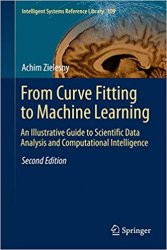From Curve Fitting to Machine Learning: An Illustrative Guide to Scientific Data Analysis and Computational Intelligence, 2nd Edition
- Добавил: literator
- Дата: 19-08-2019, 14:46
- Комментариев: 0
 Название: From Curve Fitting to Machine Learning: An Illustrative Guide to Scientific Data Analysis and Computational Intelligence, 2nd Edition
Название: From Curve Fitting to Machine Learning: An Illustrative Guide to Scientific Data Analysis and Computational Intelligence, 2nd Edition Автор: Achim Zielesny
Издательство: Springer
Год: 2016
Страниц: 509
Язык: английский
Формат: pdf (true)
Размер: 35.6 MB
This successful book provides in its second edition an interactive and illustrative guide from two-dimensional curve fitting to multidimensional clustering and machine learning with neural networks or support vector machines. Along the way topics like mathematical optimization or evolutionary algorithms are touched. All concepts and ideas are outlined in a clear cut manner with graphically depicted plausibility arguments and a little elementary mathematics.
The major topics are extensively outlined with exploratory examples and applications. The primary goal is to be as illustrative as possible without hiding problems and pitfalls but to address them. The character of an illustrative cookbook is complemented with specific sections that address more fundamental questions like the relation between machine learning and human intelligence.
All topics are completely demonstrated with the computing platform Mathematica and the Computational Intelligence Packages (CIP), a high-level function library developed with Mathematica's programming language on top of Mathematica's algorithms. CIP is open-source and the detailed code used throughout the book is freely accessible.
Welcome to machine learning! Always keep in mind that machine learning is (and unfortunately remains) a lot of laborious trial and error. It opens a space with fantastic opportunities but may often lead to dramatic failure. Since pairs of inputs x k = (x k1 , x k2 , ..., x kM ) and corresponding outputs y k = (y k1 , y k2 , ..., y kN ) are mandatory for machine learning its training (or optimization) process is called supervised learning where the learning is controlled (or supervised) by the known outputs - in contrast to the unsupervised clustering of inputs without any control. Machine learning may address a regression or a classification task and usually involves multidimensional input and output vectors (i.e. N and M are usually substantially larger than one).
As already mentioned it may be regarded as a generalization of 2D data smoothing (with N and M equal to one) to multiple dimensions. Note that errors of the y data are usually not taken into account since machine learning lacks a sound statistical basis due to the missing knowledge of the model functions’ structures. In this chapter different machine learning methods are sketched: Multiple linear and polynomial regression (MLR, MPR), three-layer feed-forward neural networks (three-layer perceptrons) and support vector machines (SVM). MLR and MPR are usually not accounted as machine learning techniques but perfectly fit into this book as a (fast) start. Perceptrons and SVMs are prominent machine learning methods and are widely used (not only) in science and engineering. For a successful application of machine learning unfortunately a lot of subtleties have to be taken into consideration and a lot can go wrong.
Скачать From Curve Fitting to Machine Learning: An Illustrative Guide to Scientific Data Analysis and Computational Intelligence, 2nd Edition
Внимание
Уважаемый посетитель, Вы зашли на сайт как незарегистрированный пользователь.
Мы рекомендуем Вам зарегистрироваться либо войти на сайт под своим именем.
Уважаемый посетитель, Вы зашли на сайт как незарегистрированный пользователь.
Мы рекомендуем Вам зарегистрироваться либо войти на сайт под своим именем.
Информация
Посетители, находящиеся в группе Гости, не могут оставлять комментарии к данной публикации.
Посетители, находящиеся в группе Гости, не могут оставлять комментарии к данной публикации.
